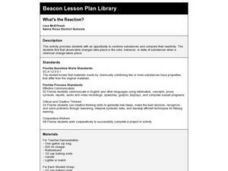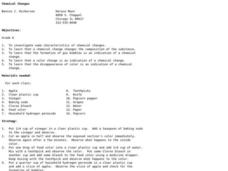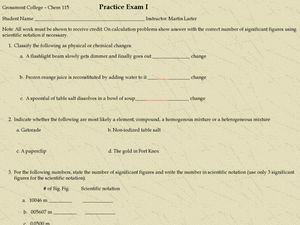Curated OER
What's the Reaction?
Students combine baking soda and vinegar and observe the chemical and physical changes that this mixture can produce.
Curated OER
Changes in the Copper Penny
Third graders explore the difference between a physical change in a substance and a chemical change. students study the volume, density, altering shape and chemistry of a copper penny.
Curated OER
Science Jeopardy
Young scientists form teams and compete by providing questions for words and phrases related to science topics arranged in a Jeopardy quiz show game format. The categories include matter, measurement, vocabulary, and chemical or physical...
Curated OER
Changing Matter
Fifth graders conduct an experiment. In this changing matter lesson plan, 5th graders receive a cup of crystals, record their observations, add water to the crystals and record new observations. Students then discuss the differences...
Curated OER
Chemistry: Changing Materials
Students examine physical change with different temperature and solvents. In this elements and compounds lesson, students conduct experiments to discover what happens to the mass of a substance when is undergoes a physical change.
Curated OER
Physical and Chemical Changes in Matter
Students investigate chemical and physical changes. In this chemical and physical changes lesson plan, students distinguish between a chemical and physical change when observing baking bread and hot dogs and bagels cooking on a grill....
Curated OER
Chemical Changes
Sixth graders explore chemical and physical changes. In this lesson about chemical changes, 6th graders observe various items and changes that occur at certain times. Students determine what change took place and observe the change....
Curated OER
Chemistry Basics Practice Exam
In this chemistry practice activity, students solve sixteen problems including identifying chemical and physical changes, calculating numbers with significant figures, naming compounds and writing formulas and converting from one unit to...
Curated OER
Describing the Physical World
In this physical world worksheet, students review concepts relating to the chemical and physical properties of matter, density of matter, and if matter is a solid, liquid, or gas. This worksheet has 9 terms in a word puzzle, 4 true or...
Curated OER
Chemical and Physical Changes
Young scholars experiment, identify and apply the concepts of chemical and physical changes utilizing real-world examples. They discuss and model physical and chemical changes, answer guided questions and play a game that reinforces the...
Curated OER
Kitchen Chemistry
Fifth graders examine both physical and chemical changes, and how to identify the difference between the two. They observe the changes that occur in butter when it is exposed to heat and cold, heat energy. In their notebooks, they write...
Curated OER
Snowflake Crystals
Fourth graders explore physical changes and the true life story of Wilson Bentley. They observe the changes that take place with snowflakes. Students discuss what happens when snow flakes melt. They create their own snowflakes using...
Curated OER
Experimenting with Physical Changes
Fourth graders explore physical changes. They discuss that physical change is a change in size, shape, or state of matter of a substance. Students explore what change takes place when two substances can dissolve each other. They observe...
Curated OER
Physical and Chemical Changes - Making Toffee
Fourth graders make toffee to observe both physical and chemical changes. They determine what types of changes that are caused by the cooking process and which are chemical, and which are physical. In order to do this they follow a...
Curated OER
Ice Cream Chemical and Physical Changes
Fourth graders identify characteristics of a simple physical and chemical change. They describe objects by the properties of the materials from which they are made and that these properties can be used separate. Students describe the...
Curated OER
Reversible and irreversible changes
Students define the words "reversible" and "irreversible." They complete a worksheet that shows a number of changes. Students must decide which are reversible and which are irreversible.
Curated OER
How to identify a physical change from a chemical change
Learners identify the difference between some physical and chemical properties and compare some physical and chemical changes. They design an experiment to distinguish between a physical or a chemical property of their choice.
Curated OER
What's Happening in My World?
Students look for examples of chemical and physical changes in the world around them and complete "What's Happening in My World" worksheet.
Curated OER
Changes in Matter
Eighth graders, in groups, explain the difference between physical and chemical changes.
Curated OER
Physical/Chemical Properties of a Burning Candle
Students investigate the physical and chemical properties of a candle before and after it is lit. They conduct a burning candle experiment, and complete a KWL chart and worksheet, recording the results of the investigation.
Curated OER
Physical and Chemical Changes
Sixth graders complete several experiments about chemical and physical changes. In this physical and chemical science lesson, 6th graders complete 6 experiments about chemical and physical changes. Students examine the processes of...
Curated OER
Matter - Chapter 2 Physical Changes
In this matter worksheet, students identify words and match them to their definition. Students identify words dealing with matter, its physical changes, and the effect of heating and cooling matter. This worksheet contains nine...
Curated OER
The Same But Different
Fourth graders identify the characteristics of a simple physical change. They describe objects by the properties of the materials from which they are made. Students discuss the different states of matter and their distinct physical...
Curated OER
Salt and Water Divorce by a Physical Change
Students discuss the definitions of physical and chemical properties and changes. They vaporize a solution of salt and water, observing the sodium chloride that is left behind.

























